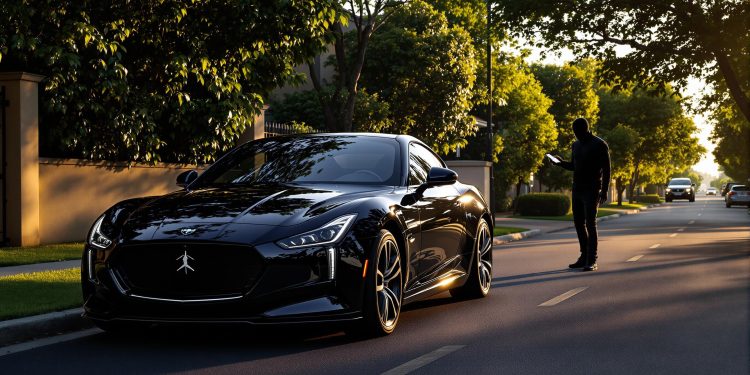Keyless entry cars are convenient but come with serious risks in South Africa. Criminals exploit their technology using relay attacks, signal jamming, and key cloning, making these vehicles prime targets. With 5-6 keyless cars stolen daily and R8.5 billion lost annually, owners face higher insurance premiums and financial losses.
Key Points:
- Top targets: Toyota Hilux, Fortuner, Corolla, VW Polo, Golf, and luxury brands like BMW and Mercedes-Benz.
- Theft hotspots: Gauteng accounts for 58% of vehicle thefts.
- Insurance impact: Premiums for keyless cars are 15-20% higher.
- Prevention tips: Use GPS trackers, signal-blocking pouches, and physical deterrents like steering wheel locks.
Take action: Combine physical and electronic security measures to reduce theft risks by up to 75%.
Keyless Car Theft in South Africa: Methods, Risks, and Solutions
Rising Keyless Car Theft in South Africa
Methods of Keyless Car Theft
Thieves in South Africa are using advanced tactics to exploit keyless car systems. Here are the top three methods:
- Relay attacks: Devices amplify the signal from a key fob inside a home, allowing thieves to unlock and start cars parked outside without physical access [7].
- Signal jamming: Criminals block the locking signal when owners try to secure their vehicles. Many unknowingly leave their cars unlocked, making theft easier [1].
- Key cloning: Using specialized tools, thieves can program blank key fobs or replicate legitimate key signals, leaving no signs of forced entry [7].
These methods have made keyless cars a common target, with an estimated 5-6 keyless vehicles stolen daily in 2023.
Keyless Car Theft Data and Trends
The province of Gauteng leads in vehicle theft cases, accounting for 58% of national incidents. This trend highlights its mix of economic activity and organized criminal networks. Insights from Tracker‘s 2023 data reveal:
| Region | Crime Share | Notable Trends |
|---|---|---|
| Gauteng | 58% | Theft rates exceed hijackings (53% vs 47%) |
| Eastern Cape | – | Business vehicles 9x more likely to be hijacked |
| National | 100% | Hijackings: 54%, Theft: 46% |
In the last quarter of 2023 alone, authorities recorded 5,937 carjackings, with keyless vehicles making up 5-6 thefts daily.
Reasons for Targeting Keyless Cars
Keyless entry vehicles are a prime target for organized crime due to several factors:
- High resale value: Newer models, especially luxury SUVs, fetch high prices on the black market [5].
- Minimal damage: These cars are often stolen without physical damage, preserving their resale value and delaying detection.
- Exploitable technology: Criminals take advantage of gaps in security systems that lag behind advancements in automotive technology [7].
Tracker’s Chief Operating Officer, Duma Ngcobo, explains:
"Crime tends to shift across provinces over time, and there are different levels of crime based on the sophistication of the crime syndicates in the province." [3]
With organized crime groups focusing on high-end vehicles, the combination of technological weaknesses and high demand makes keyless cars a lucrative target.
High-Risk Keyless Car Models and Brands
Most Stolen Keyless Car Models
Certain models like the Toyota Hilux, Fortuner, and Corolla, along with the Volkswagen Polo and Golf, are frequent targets for car thieves. Their popularity on the black market for parts makes them especially vulnerable. In urban areas of Gauteng, luxury brands like BMW, Mercedes-Benz, and Audi are also heavily targeted. Their advanced tech and high resale value make them appealing to criminals [3][8].
Factors Increasing Theft Vulnerability
Several factors contribute to the increased risk of theft for some keyless vehicles:
- Always-active fobs: These allow relay attacks by constantly emitting signals.
- Outdated software: Older systems often lack critical security updates.
- Basic immobilizers: Many rely on single-layer security without additional verification methods.
Older keyless systems are especially prone to theft due to weak encryption that can be easily cracked. Additionally, key fobs with extended range create more opportunities for relay attacks [5].
Comparison of High-Risk and Low-Risk Models
The table below highlights the differences in security features between high-risk and low-risk keyless car models:
| Security Feature | High-Risk Models | Low-Risk Models |
|---|---|---|
| Signal Security | Basic RFID | Ultrawideband (UWB) technology |
| Authentication | Single-factor | Multi-factor (e.g., PIN/biometric) |
| Immobilizer | Standard | Advanced with rolling codes |
| Security Updates | Rare or absent | Regular over-the-air updates |
| Range Control | Extended signal range | Limited signal distance |
Brands like BMW and Mercedes-Benz are leading the way in adopting stronger security measures. For instance, UWB technology has been effective at reducing the likelihood of relay attacks. More details on these advancements will be covered in the ‘Anti-Theft Technologies’ section.
sbb-itb-09752ea
Financial and Insurance Impacts of Keyless Car Theft
Financial Losses from Keyless Car Theft
Keyless car theft isn’t just a safety issue – it has major financial consequences. In South Africa, it results in losses of R8.5 billion annually, including vehicle losses and the costs tied to insurance claims and processing [1].
Stolen keyless vehicles have a recovery rate of just 45%, much lower than the 60% recovery rate for traditionally stolen cars [3]. Organized crime’s ability to quickly dismantle these vehicles for parts – covered in ‘Reasons for Targeting Keyless Cars’ – plays a big role in this. This efficiency drives up insurance claims, with keyless car theft claims averaging R350,000, compared to R250,000 for cases involving traditional car theft.
Changes in Insurance Premiums
Insurance companies are adjusting to the increased risk by raising premiums. Vehicles with keyless entry now see premiums rise by 15-20% compared to those with traditional keys [2].
To encourage the use of anti-theft solutions, insurers offer discounts for certain security measures, as detailed below:
| Security Measure | Cost Range | Potential Premium Discount |
|---|---|---|
| GPS Tracking Device | R1,500 – R3,000 | 10-15% |
| Advanced Immobilizer | R1,000 – R2,000 | 5-10% |
| Steering Wheel Lock | R500 – R1,500 | 3-5% |
| Signal-blocking Pouch | R200 – R500 | 2-3% |
Insurance Requirements for Keyless Car Owners
To address these risks, insurance providers now require keyless car owners to implement specific protections [5]:
- GPS tracking systems: Must be professionally installed and include 24/7 monitoring.
- Physical deterrents: High-quality steering wheel or pedal locks.
- Signal protection: Use of signal-blocking pouches for key fobs.
- Secure parking: Cars must be parked in monitored or secure areas.
- Regular maintenance: Security systems must be updated regularly.
Banks are also revising lending terms to account for these risks, aligning their requirements with the vulnerabilities discussed in earlier sections. This shift emphasizes a stronger focus on security for both owners and insurers.
Preventing Keyless Car Theft
Tips for Keyless Car Owners
Keyless car theft is a growing concern in South Africa, but there are practical steps you can take to protect your vehicle. Start with proper storage of your key fob. Using a signal-blocking Faraday pouch can prevent criminals from intercepting and amplifying its signal. These pouches, priced between R200 and R500, are a simple yet effective way to counter relay attacks and cloning attempts.
Other precautions include using a visible steering wheel lock and parking in well-lit, monitored areas to discourage thieves. Always double-check that your car is locked, as signal jammers can interfere with locking mechanisms. Keeping your car’s software up to date is also key, as updates often address security vulnerabilities. For extra protection, consider installing motion-sensor lights or CCTV cameras at home.
New Anti-Theft Technologies
To address security flaws in certain car models, manufacturers are rolling out advanced solutions to combat keyless car theft in South Africa. For instance, modern immobilizers now use sophisticated algorithms to block signal cloning. Ultra-wideband (UWB) technology is another breakthrough that makes relay attacks much harder to execute compared to traditional key fobs.
Biometric access systems are also becoming more common in newer cars, adding another layer of security. Geofencing technology, which alerts owners if their vehicle moves beyond a set area, is gaining traction as well [5]. Some manufacturers have even introduced smartphone apps that allow remote monitoring and emergency disabling of vehicles.
Effectiveness of Anti-Theft Measures
Not all security measures are equally effective, so understanding their strengths can help you make informed decisions. Here’s a breakdown of some popular options:
| Security Measure | Effectiveness | Recovery Rate |
|---|---|---|
| GPS Tracking | Very High | 85% |
| Advanced Immobilizer | High | N/A |
| UWB Key System | High | N/A |
| Signal Blocking + Physical Lock | Medium-High | N/A |
| AI-Based Security System | Very High | 90% |
Using a combination of these measures can lower theft risk by up to 75%. Insurers often reward such layered security efforts with reduced premiums. The best strategy is to combine physical deterrents, electronic safeguards, and monitoring tools to create a well-rounded defense against theft attempts [4][5].
Conclusion: Managing Keyless Car Theft Risks
Key Takeaways
Keyless entry cars in South Africa are increasingly targeted, with an alarming 5-6 vehicles stolen daily through techniques like relay attacks and signal jamming. Among the available countermeasures, GPS tracking systems stand out as the most reliable. Tracker’s GPS systems, for instance, achieved an impressive 90% recovery rate in 2023, recovering over 17,000 stolen vehicles [6]. These results reinforce the importance of combining GPS tracking with physical deterrents (discussed in ‘Effectiveness of Anti-Theft Measures’).
The financial toll of keyless car theft is staggering, with losses reaching R8.5 billion annually [1]. This highlights the importance of adopting the layered security strategies detailed in this article, particularly for models identified as high-risk.
Practical Tips for Keyless Car Security
Emerging technologies like biometric authentication and AI-based detection systems are shaping the future of vehicle security. Some newer models already feature biometric systems, offering a promising step forward. However, the most effective strategy today combines traditional physical deterrents with modern electronic measures.
To stay ahead of sophisticated theft tactics, car owners should focus on these key steps:
- Use GPS tracking systems alongside signal-blocking tools.
- Add physical deterrents like steering wheel locks or immobilizers.
- Stay informed about regional theft trends and adapt security measures accordingly.
Related Blog Posts
- How To Protect Used Cars From Theft
- 8 Ways To Prevent Used Car Theft
- Top 5 Cars for South African Roads
- 10 Tips to Avoid Car Scams in South Africa





